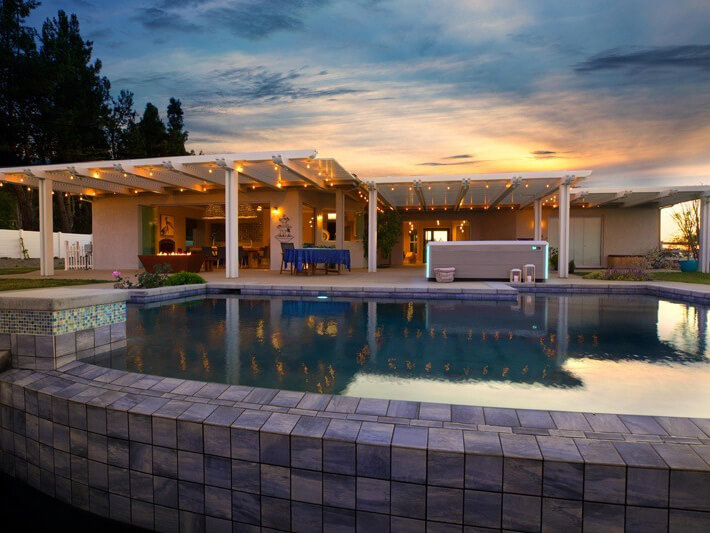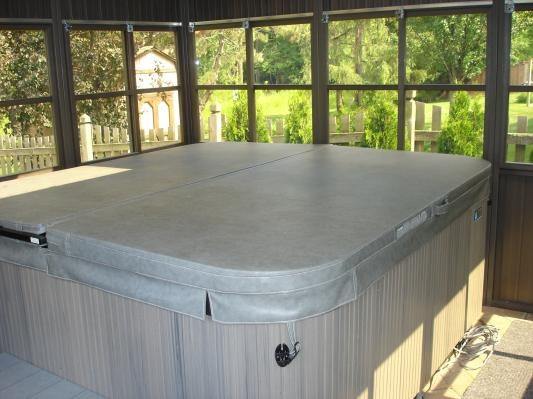
Whether your desire to own a hot tub was sparked by spending an enjoyable evening in a friend's outdoor spa or unwinding in a spa inside a hotel suite, your experiences were probably similar. As the powerful jets massaged your muscles and the warm water rejuvenated your body and mind, you felt relief and comfort. Both indoor hot tubs and outdoor spas offer pleasure, the healing benefits of hydrotherapy, and convenience. Regardless of whether your spa is inside or outside, a wonderful soak is just steps away.
Discover the revolutionary spa jet systems available today.
While the only true difference between indoor and outdoor hot tubs is location, where you choose to place your spa makes a world of difference when it comes to installation, maintenance, and how you plan to use your spa. So, to help you decide whether an outdoor spa or an indoor hot tub is best for your lifestyle, we've listed the pros and cons of each below.

Indoor Hot Tubs Pros and Cons
Nowhere is privacy more relished than in your home. You can go from your indoor hot tub to your shower to bed without ever worrying about prying eyes. But installation of an indoor spa could cause you to make big changes in your home and stretch your budget. Here's a roundup of all the pros and cons of owning an indoor hot tub:
Pros of Owning an Indoor Hot Tub
- Privacy. Whether you live in an urban or suburban neighborhood, placing your hot tub inside your house will shield you from the inquisitive gazes of passers-by and neighbors.
- Ultimate Convenience. Sure, both indoor and outdoor spas are convenient, but a spa in your home means more than just taking a few extra steps to use it. You can use it anytime, without even putting on sandals.
- Protection from the Elements. Weather isn't a worry when your spa is placed indoors. You'll never have to apply sunscreen before stepping into your hot tub, or worry about wind, rain, or snow. Your cabinet and cover will remain unblemished by the elements and airborne allergens won't be a concern.
- Maximizes Unused Space. If you have a large house or your kids have gone off to college or to raise families of their own, you might have extra room. Installing a hot tub in your home will turn an unused room into your private paradise.

Cons of Owning an Indoor Hot Tub
Installing and maintaining an indoor hot tub is no simple feat. Successful installation may require a lot of planning and making alterations to your home. You might even want to consider hiring a general contractor to oversee the project. But depending on how you plan to use your indoor spa, the extra time and cost you'll put into it could be worth it. Here are the cons to owning your own indoor hot tub:
- Installation Route. Hot tubs come in all sizes and most are larger than doorways, and maneuvering them down corridors and around corners isn't always possible. Before purchasing a hot tub, review its specifications or pre-delivery instructions and measure doorways and hallways along the delivery path. You might need to make minor or major alterations to your home to fit the hot tub you want.
- Base Installation. You'll need a solid foundation for a portable hot tub. When filled with water, your spa can weigh over 5,000 pounds. Unless you intend to place the hot tub on your basement slab, your home floor will likely require significant reinforcement. Speak to a structural engineer or your local hot tub dealer for guidance on performing structural work safely and successfully.
- Plumbing. Not every room in the house has running water. If your proposed spa location does not have a faucet and sink, you'll want to install one so you can easily drain and refill your hot tub at least once a year, depending on your spa water care system. You could run a hose from outside, but that might be impossible in multifamily units.
- Drains. Incidental water displacement occurs with moderate regularity when people enter, exit, or move around in a hot tub, especially when the jets are on. Unless you install a drain, spilled water will remain on the floor and could cause costly damage. If you don't install a drain, you'll have to run a hose to the nearest indoor or outdoor sink or drain to empty your spa.
- Electrical Installation. To connect your hot tub to power, you can either plug it into a wall outlet or wire it directly to a 220v, 230v, or 240v connection through your home's central circuit breaker box. If you don't have a proper wall outlet, you'll need to install one. To prevent moisture-related short circuits, you'll also need to install a ground fault circuit interrupter (GFCI) between your hot tub and power source as well. A licensed electrician should perform this work.
- Ventilation. Heated spa water evaporates and increases the relative humidity of the surrounding air. The combination of heat and humidity may damage your wall coverings, paint, plaster, or drywall, and provides an ideal environment in which undesirable bacteria and fungi can grow. To mitigate the ambient dampness and any odor, you'll need to invest in an efficient ventilation system.
- Water-Resistant Building Materials. To prevent costly damage to the floor, walls, and ceiling of the room in which you place your spa, you'll want to invest in water-resistant building materials. Home accessories, including furniture and electronics, should be water resistant as well, to safeguard against the increase in humidity, condensation, and potential spa water overflows.

Outdoor Hot Tubs Pros and Cons
Outdoor hot tubs are easier to install than indoor spas and simpler to maintain. Plus, high-quality spas are built to withstand the elements. Durable, weather resistant cabinets stand up to the wind and the rain, while heavy vinyl covers protect your hot tub's interior. The downsides? There are few. Here are the pros of installing a hot tub outdoors.
Pros of Owning an Outdoor Hot Tub
- Easier delivery and installation. It's easier to install a hot tub in your backyard or on your deck than in your home. While you will still need to install a foundation and make the required outdoor electrical connections, the overall cost of installation should be lower. You'll also still need to make sure that the delivery route is clear of debris and that the spa can fit down the path. Even if you have to move a section of fence to get the spa to its location, it's better than moving a wall.
- Open Ventilation. Outside, you don't have to worry about proper ventilation. Any excess humidity your hot tub creates will be blown away by the wind and have no negative effect on your deck or patio.
- Natural Drainage. Unlike installing a hot tub indoors, you'll worry a lot less about drainage when changing your outdoor spa water. You can choose to eliminate the need to install a drain if you place your outdoor spa within a short hose length from a natural drainage site.
- Beautiful Setting. There's something about relaxing year-round in an outdoor spa that an indoor spa can't match. In a backyard spa, you can admire your landscaping, watch the sunset, listen to the birds sing, and smell the many different aromas of the seasons. You'll become one with your environment.

Cons of Owning an Outdoor Hot Tub
There aren't many downsides to owning an outdoor hot tub, so the upsides easily take the day. That said, there are a few considerations to keep in mind before you decide on an outdoor hot tub.
- Less Private. If you can see your neighbors from your backyard spa, they can see you. So, if you crave privacy, you'll need to install a fence or get creative with your landscaping. Trees and shrubs can add beauty, after all. Your cover lifter might also double as a screen. The UpRite® cover lifter, for example, also acts as a shield to keep your soaks private.
- Slightly Less Convenient. You'll have to go outside to enjoy your hot tub—in the sunshine and when it's cold or raining. You'll also have to go outside to test and adjust your spa water, clean the filters, and conduct all maintenance. The good news? Very few spa owners mind.
In some areas, like entertainment, both indoor and outdoor hot tubs excel. Some spa manufacturers, including the manufacturers of Hot Spring® spas, offer entertainment systems standard, with the option to upgrade. Do you want to watch the big game from the comfort of your spa? You can do that by adding an HD TV monitor.
Choosing whether to place your hot tub indoors or outdoors will greatly depend on how you plan to use your new spa. Now that you know the trade-offs of each location, you can decide which is right for your lifestyle and learn more about the features and options available with various hot tub collections and models.
We design our hot tubs with you and your lifestyle in our mind. Elegantly sculpted to adorn an interior room or an outside deck, every one of our expertly engineered spas is made to ensure your enjoyment for years to come. To view the full Hot Spring line of 2018 hot tubs, download our brochure.